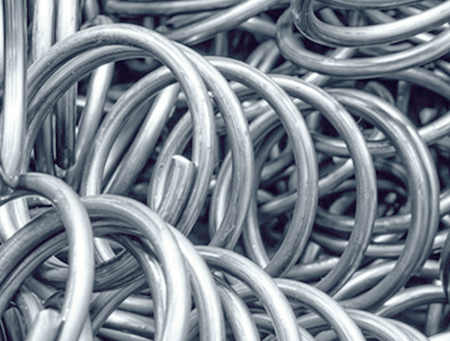A Look at the Stainless Steel Families
Central Wire Industries carries stainless steel alloys that usually fall into four categories: austenitic, martensitic, ferritic and duplex. Each family is made up of a different chemical composition, creating different advantages and disadvantages of the alloy.
These alloys become our wire products, from round wire to slicklines. Unsure which alloy family is right for your application? Consider the following highlights from each family:

Austenitic steels
Austenitic steel’s crystalline structure prevents it from being hardenable by heat treatment, making them essentially non-magnetic. For example, the 302S alloy is a tough, ductile grade with comparable corrosion resistance, is non-magnetic and does not harden by heat treatment. This alloy is often used for pressure containing applications and sanitary or cryogenic applications.
Martensitic steels
Many of our 400-series stainless steels have a high carbon content, giving them a martensitic crystalline structure. Martensitic steels provide high strength and high wear resistance, however, they aren’t as corrosion resistant as the austenitic types. These steels can be hardened by heat treatment to higher strength and hardness level. Consider the 416 stainless steel alloy, which is a high-chromium martensitic free-machining stainless steel that is often used for any part that requires considerable machining.
Ferritic steels
For steels with corrosion resistance, consider a ferritic stainless steel. Ferritic steels must contain at least 10.5 percent chromium. For example, our 409 stainless steel is a ferritic steel that offers good mechanical properties and high-temperature corrosion resistance. It is commonly considered a chromium stainless steel, with applications in exhaust systems of automobiles and applications that demand weldability.
 Duplex steels
Duplex steels
Duplex steels, or austenitic-ferritic steels, are named because their metallurgical structure consists of two phases, austenite and ferrite. They usually contain a higher chromium content, higher molybdenum content and a lower nickel content. They are designed to provide higher corrosion resistance and strength. As an example, our SUPA®-GD100™ slickline wireline is a duplex stainless suitable for well conditions with aggressive concentrations of CO2, H2S and chlorides.
All stainless steel metals are not created equally. Austenitic, martensitic, ferritic and duplex steels all have different levels of magnetism, corrosion resistance and strength. Still not sure what family to select? At Central Wire Industries, our sales department is committed to helping you find the right product for your application or industry. Contact our knowledgeable salespeople today at sales@centralwire.co.uk or +44-(0)-1709-37-6625 to learn more about our stainless steel alloys.
